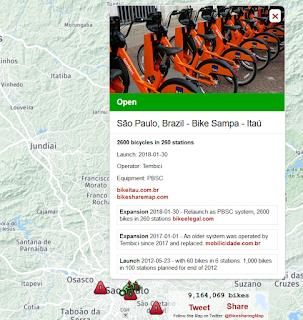The Bike-sharing World Map today
As I quoted Lyon, France’s mayor in the 1/21/08 blog post, “There are two types of mayors -- those who have bike-sharing and those who want bike-sharing.” Fortunately, not long after that post, Russell Meddin joined me in curating the Map and eventually became the Map’s sole curator with a substantial time commitment over his morning coffee. Since then, the Map has grown to over 3,000 entries, painstakingly added one-by-one over the past 13 years as each unique new service develops, implements, and in some cases, permanently closes.
Today, we’re excited to announce that we’re relaunching The Meddin Bike-sharing World Map at bikesharingworldmap.com. To honor Russell, we’ve renamed the new Map after him.
The Meddin Bike-sharing World Map
The features of the new Map include:
- easier-to-read map to see the depth and breadth of bikeshare systems around the world;
- a search feature to find quickly what you’re looking for;
- a live count of global bikes and systems being planned, in operation, seasonal, temporarily closed, no longer operating, and never opened; and
- images of newly added systems.
Updated entry feature of the Map
If you’re aware of a new bikeshare system or changes to existing systems, you can reach us at bikesharingworldmap @ gmail.com. The Map is a labor of love for all of our team members as we donate our time for the sake of bikeshare and to continue Russell’s decade of effort.
On behalf of our international team, we hope you like The Meddin Bike-sharing World Map.
Sincerely,
Paul DeMaio








